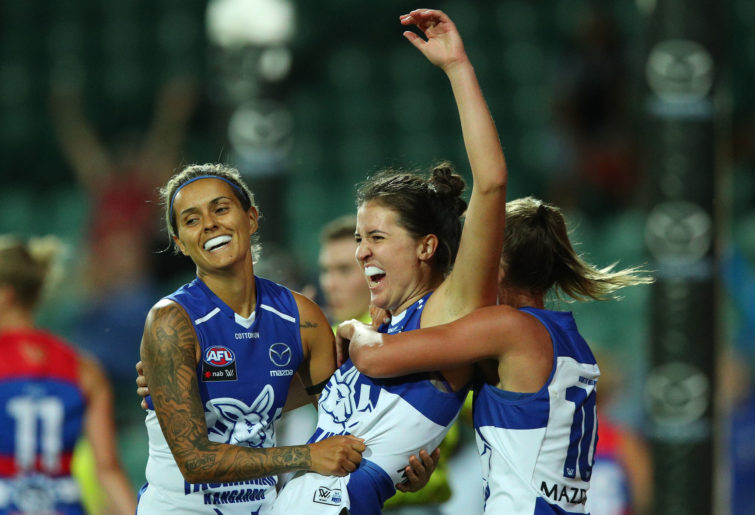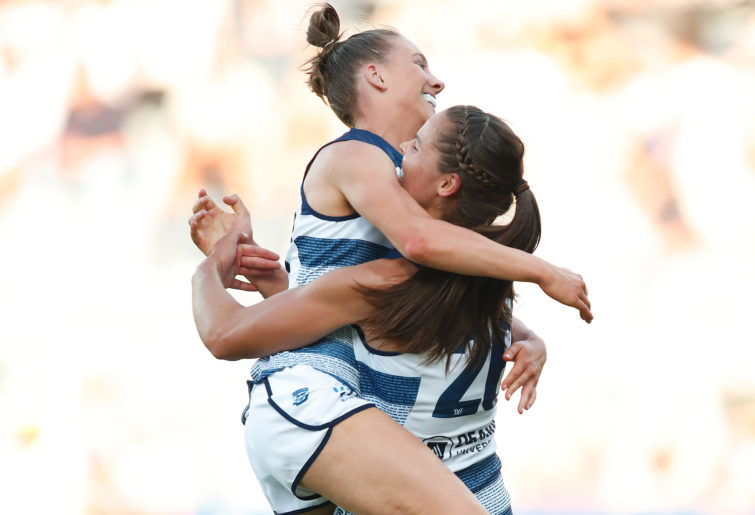Fact: Everyone’s predictions sucked last week, so I didn’t feel terrible about only going two for five.
On the other hand, the numbers look good to me for Round 5 on the ‘ELO-Following Football’ ratings chart, so let’s see what they spit out before we get into some further facts about the AFLW season to date:
Brisbane vs Geelong at Moreton Bay Central Sports Complex
We have the Lions by 7.6 points, and we’ll ride that number. Whatever the problems with the conference system, the fixture has produced the right games at the right times in the fixture.
Carlton vs Collingwood at Ikon Park
The ‘traditional’ (for two years) schedule opener shows up in Round 5, and we have the Blues as 8.2-point favourites. Win and we’ll get yet another top-of-the-ladder game between the Blues and Lions next week.
Greater Western Sydney vs Melbourne at Blacktown International Sportspark
While GWS won and the Demons lost last week, you can hardly consider them the hot team coming into this one. We have Melbourne as 15.2 points to the good in this game. It could be less, it could be much more, but that feels like the centre of the bell curve of possibilities here.
North Melbourne vs Adelaide at Avalon Airport Oval
Once again the pressure’s on the new kids, whose roster is filled with the old kids from the other teams, and once again we expect them to come through and remain undefeated. We favour the Shinboners by 7.8 points, although after last week we’ll just bet the win, thank you.
Fremantle vs Western Bulldogs at Fremantle Oval
It seems unfair that the defending champs should be the first team knocked out of finals contention – and it’s possible Collingwood will beat them to it, depending on outcomes – but we favour the purple side by 11.2 points here, which will put the Dogs at least two games plus a head-to-head behind both Freo and the Kangaroos, thus knocking them out of the possibility of a top-two Conference A finish. Yes, there would technically be a percentage possibility if they win the last two games 100-0. Don’t bother, Western fans; just prepare for the men’s season if they lose here.
Last week: 2-3, and thankful for even that much success.
Overall: 13-6-1.
But now onto some further interesting facts.
Fact: In Round 3 North Melbourne played the team seen as their chief rival, the 2-0 defending premiers, the Western Bulldogs, who had the highest ELO-FF rating in the league besides the Kangaroos. The Kangaroos won 53-22.
Fact: In Round 4 North Melbourne played the team seen at the time as their chief rival, the 2-1 Melbourne Demons, coming off a 39-point win against Brisbane and whose only loss was less than a goal while scoring 55 points themselves against Fremantle. The Demons also at game time had the highest ELO-FF rating in the league after the Kangaroos. The Kangaroos won 38-34.
Fact: In Round 5 North Melbourne will play the team now seen as their chief rival, the 3-1 Adelaide Crows, who enter the round on a three-game win streak, having dismantled the Dockers by 42 points and whose only loss was by one-point downing to the Doggies. And, yes, they currently have the highest ELO-FF rating in the league after the Kangaroos. Would you be surprised to know that we favour the Kangas to win this game as well?

Courteney Munn of the Kangaroos. (Graham Denholm/Getty Images)
Fact: In Round 7 North Melbourne will play the team who will undoubtedly then be considered their chief rival, the Fremantle Dockers, who are currently 3-1 and have two games between now and then they will be favoured to win, which would make them 5-1 – and, yes, it will probably give them the best ELO-FF rating before Round 7. Just a hunch.
Fact: Ellie Blackburn may be the toughest player in this entire league. She’s taken a lickin’ and kept on tickin’, suffering another pounding in the game against Brisbane last Saturday. And yet she continues to excel for the Bulldogs – in fact she’s in the top ten league-wide for the meta-player of the year standings and sits alone atop the Western Bulldogs ladder.
This is the top 20 list for that meta-player of the year title after four of seven rounds. We use nine sources for our point totals here as opposed to 14 for the men. Asterisks mark the top player for each team.
- Erin Phillips, Adelaide* – 112 points
- Ally Anderson, Brisbane* – 100 points
- Madison Prespakis, Carlton* – 97 points
- Emma King, North Melbourne* – 89 points
- Ebony Marinoff, Adelaide – 88 points
- Jess Duffin, North Melbourne – 87 points
- Karen Paxman, Melbourne* – 86 points
- Ellie Blackburn, Western Bulldogs* – 84 points
- Anne Hatchard, Adelaide – 84 points
- Emma Kearney, North Melbourne – 83 points
- Lauren Pearce, Melbourne – 80 points
- Kiara Bowers, Fremantle* – 77 points
- Elise O’Dea, Melbourne – 71 points
- Nat Exon, Brisbane – 69 points
- Maddy McMahon, Geelong* – 68 points
- Stevie-Lee Thompson, Adelaide – 66 points
- Jess Wuetschner, Brisbane – 66 points
- Cora Staunton, Geelong* – 65 points
- Dana Hooker, Fremantle – 64 points
- Ash Brazill, Collingwood* – 63 points
- Aliesha Newman, Melbourne – 63 points
Fact: Scoring is up. In fact scoring is up from season to season and round to round. Many articles have been written about why – I laid out the basic reasons myself two weeks ago – but the gist of it is that the skill levels of the women playing the game have improved to the point where at least half the teams in the AFLW can play a more open game than the scrum-filled version that dominated the first two seasons.
Let’s look at the actual numbers. Here are the average scores per team per game:
2017, Rounds 1 to 4: 30.72.
2017, Rounds 5 to 7: 35.50 – an increase of 15.6 per cent.
2017 season, total: 32.63 points per game.
2018: Rounds 1 to 4: 32.31
2018: Rounds 5 to 7: 39.67 – an increase of 22.8 per cent.
2018 season, total: 35.46 points per game – an increase of 8.7 per cent.
So what does 2019 look like? For Rounds 1 to 4 the average score per game is 35.88 points, which is 10.5 per cent higher than the same rounds last year.
Let’s extrapolate. If the whole season goes up 10.5 per cent, that implies the final season average would be that much higher than last year’s total – a season-long average of 39.2 points or so, meaning the average over the last three rounds clocks in just over 43.5 points per game.
Or look at it this way instead: in each of the first two years scoring increased over the back half of the season by 15 to 23 per cent. Let’s just call it 20 points for an easy figure to work with. That puts the projected average for Rounds 5 to 7 at about 43-plus as well for a season average of just about 39 too.
Is 43 points per team per game ‘watchable’ for the average fan who only knows the men’s version of the AFL? Remember that the men’s version is about ten minutes longer per quarter, making their games approximately 66 per cent longer than the women’s game. Multiply 43 points by 1.66 and you’d have each team scoring an average of about 71 points per team per game, nearly approaching the men’s 2018 average of 83.
Yeah, it’s more than ‘watchable’. So if you haven’t tried AFLW this season, go and watch it.
Fact: One thing that threatens to ruin the watchability of the game for me personally is the arbitrariness of the implementation of the 50-metre penalty when a player is deemed to have interfered in the line of fire on a free kick. I’d feel the same if the men’s game enforces it this way too.
First of all, 50 metres for what in the vast majority of situations is an academic violation at most is overly severe, even when said violation actually occurs. But when the violation is as questionable as the one in the final 90 seconds of the Geelong vs Carlton game on Saturday it can unfairly change the outcome not only of a game but also of a season.
Maddie Boyd took a mark near the centre square with 83 seconds to go in the fourth quarter and her Cats up four points. Carlton had just been pushing upfield in the persons of Madison Prespakis and Darcie Vescio towards a possible game-winning goal, but great defence by superstar Meg McDonald started the ball back the other way, ending in that Boyd mark. From midfield her ensuing kick was at least as likely to land in Carlton’s hands as Geelong’s, thus allowing the Blues one more clean shot at the win.

Madeline Boyd (right) and Sophie Van De Heuvel of the Cats. (Adam Trafford/AFL Media/Getty Images)
Instead Boyd was awarded a 50-metre penalty for a mark infringement. I word it that way because after rewatching that video repeatedly over the last few days I still can’t tell you which Blues player was deemed to have strayed into the mythical protected area between Boyd and her marking point. That penalty moved her kick from near the centre square to within feasible goal-scoring range, a move that changed the probability of victory for the Cats from (wild guesses here) about 75 per cent to well over 90 per cent. Even by missing it sent the Blues all the way back into the goalsquare and lowered their chances of victory.
In fact they never got another shot on goal. Considering there were only three goals scored the entire game, you see how the severity of this penalty can affect the outcome. If Carlton scored one more goal, they’d have been leading Conference B today. As it is, they’re currently on the outside looking in. It’s as destructive as the bad penalty shot call in hockey or in the round version of football – one free shot at goal when you score only a few in a game becomes the source of random outcomes at worst and easy game fixing at best.
Look, I’m not saying the penalty should be eliminated. You couldn’t destroy the essence of this game faster than by eliminating the advantage a mark gives the receiver. But the arbitrary nature of the enforcement is driving me crazy. If you’re not solving an actual problem, let it go. If the intent to influence the kick isn’t there and there’s no effect on the set shot because of their actions, why are you inserting your officialness into the outcome of the game?
And don’t get me started on the idea that if your defender doesn’t stay in front of you while you move forward 50, you’re able to just keep going. Name one other sport that allows the offended player to choose how the penalty’s enforced. Besides ‘Calvinball’, I mean.






























































































